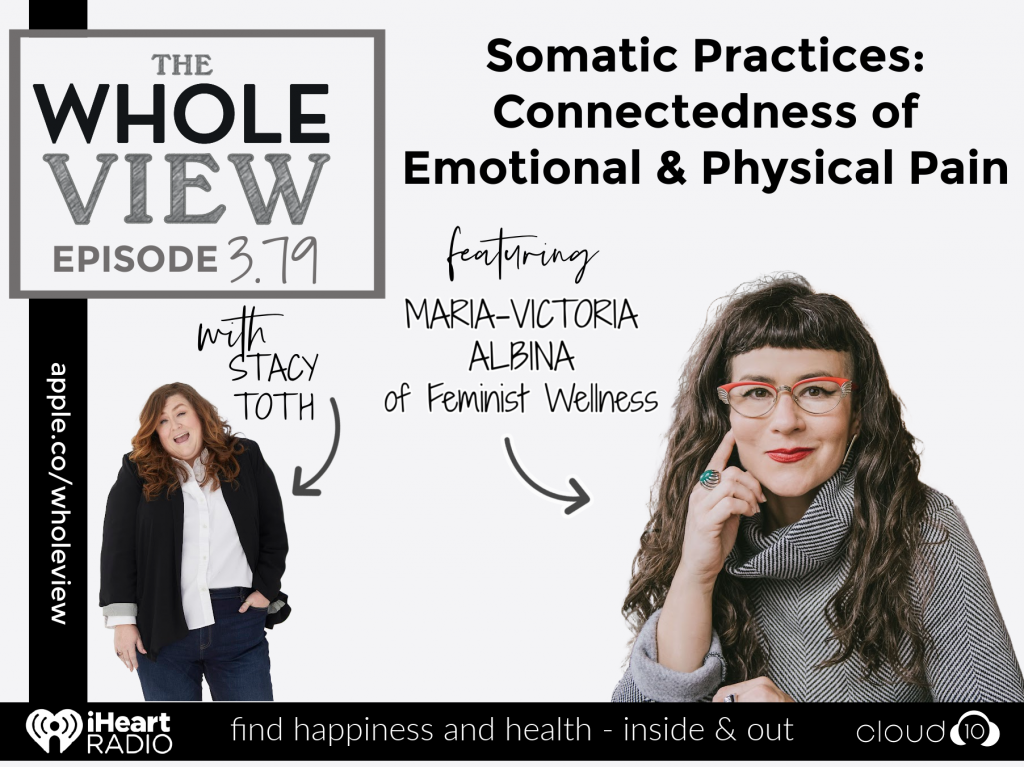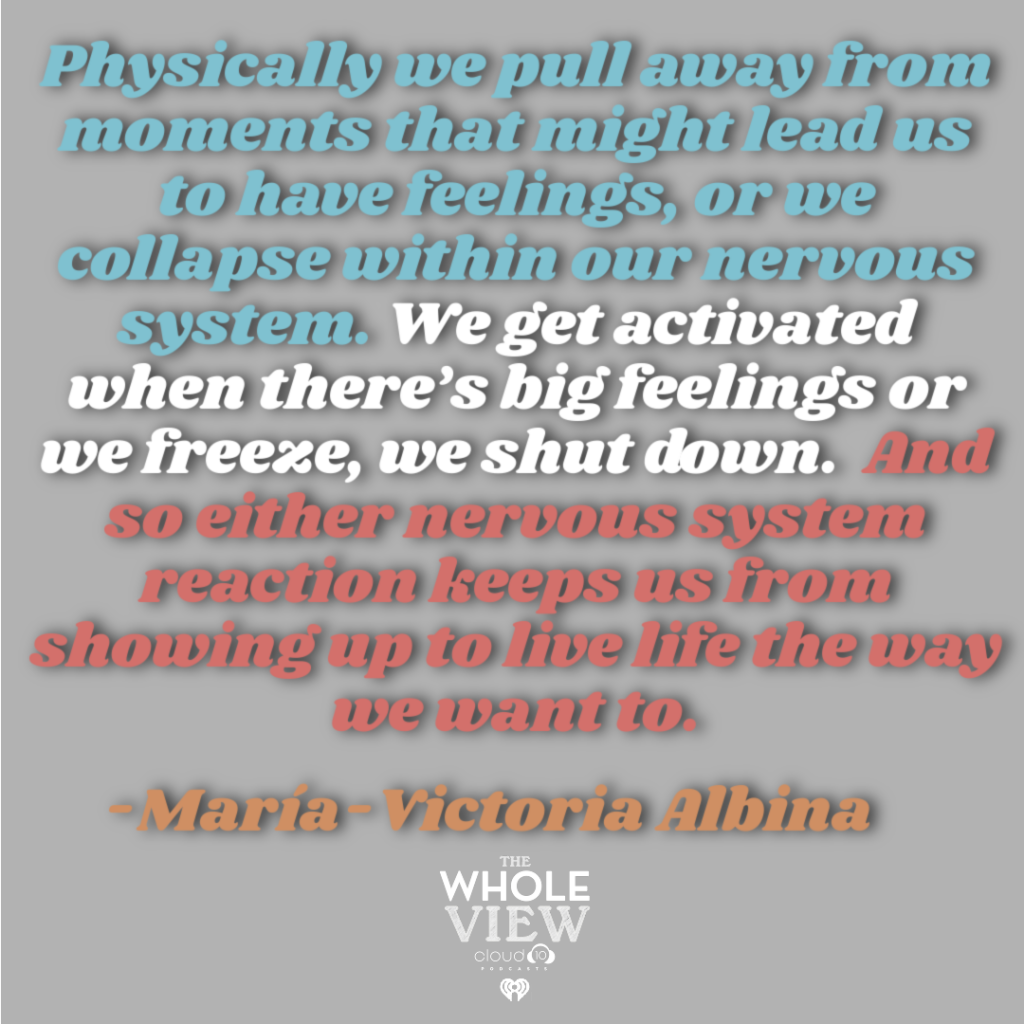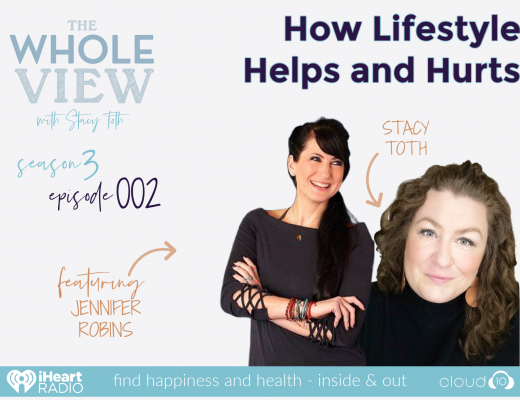Welcome Functional Medicine Nurse Practitioner and host of the Feminist Wellness podcast María-Victoria Albina to The Whole View! Stacy and Victoria discuss understanding somatic practices as the connection between mind and body, staying present to our felt experiences, and how to show the nervous system that safety is possible.

Find María-Victoria:
Get free meditations for The Whole View listeners here!
If you enjoy the show, please leave a review. Letting people know on iTunes or however you listen that it’s worth their time could change someone’s life!

Key Takeaways
Introductions
- María-Victoria Albina is a Latina Functional Medicine Nurse Practitioner, a nervous system expert trained in sensory motor psychotherapy, and the host of Feminist Wellness.
- The Feminist Wellness podcast offers empowering holistic medicine, psychology and life coaching advice for smart women who believe they can live powerful, fulfilling lives with more self-worth, self-love, and true self-care.
- Immigrating from Argentina during a war during childhood led to a passion for understanding the nervous system and healing through somatic practices.
Somatic Practices
- “Somatic Practices are the use of focused attention in cognitive and physiological processes to assess the pathological behavioral changes. This indicates mind-body interactions and also reinforces the importance of neurobiological investigations, highlighting their significant role in identifying PTSD as an organic disorder, in addition to psychopathological alterations”. [source]
- Physically we pull away from moments that might lead us to have feelings, or we collapse within our nervous system. We get activated when there’s big feelings or we freeze or shut down. And so either nervous system reaction keeps us from showing up to live life the way we want to. So this can lead to more belly aches, more joint pain, more indigestion, more headaches, more food sensitivities, more depression, more anxiety, on and on. Secondary to the unhealed wounds in our psyche and their direct impact on our physiology via the vagus nerve.
- “In a safe environment, mammals normally adapt using the social engagement system; however, depending on the degree of risk exposure in the environment, activation of the sympathetic nervous system triggers the fight-or-flight response, and the dorsal vagal system initiates the immobilization shutdown response. The involuntary neural process through which the nervous system evaluates risk is referred to as neuroception. Furthermore, the polyvagal theory explains the pathophysiology of trauma and various physical symptoms associated with ventral vagal complex dysfunction. Moreover, this may potentially be useful as a fundamental theory in psychotherapy, in which the quality of social interaction is critical”. [source]
- Our medial frontal cortex has the amygdala “brake” and is looking for any indication to throw that brake. So when we go really slow, we can bear witness to our pain and the impact in our nervous system.
Next Steps in Somatic Practices
- Somatic practice is less interested in meaning-making and more in felt experience. Because that’s what changes the experience in our nervous system is staying present to self-experience and not dying. So start to slowy, gently raise awareness of your internal physiologic state, as feeling all the feelings right away can be a little too activated.
- Often times we are living unintentionally because of habit. So, for example, in the morning, ask yourself, do you want coffee? Do you want tea? Do you even know? Find what feeling wanting feels like. Examine what a “yes” feels like.
- So try to find the felt sensation of an emotion. Does it have a color? Texture? Temperature? Does it have a weight? A pattern? Does it have a smell? Is it radiating? Is it still? Because when we go to that embodied level of those emotions, we are grounding ourselves in our felt experience.
- And then try to stay with the feeling, second by second. Can you stay with this a little bit longer? Because what supports our growth is to stay with the sensation and not the thought about the sensation.
- Orienting the nervous system is can be a tool you can do any time or place when you’re getting activated.
Studies, References & Products
- Wikipedia: Somatic experiencing
- The Body Keeps the Score: Brain, Mind, and Body in the Healing of Traumaby Bessel Van Der Kolk
- A systematic review of somatic intervention treatments in PTSD: Does Somatic Experiencing® (SE®) have the potential to be a suitable choice?, Estudos de Psicologia (Natal)
- Somatic experiencing – effectiveness and key factors of a body-oriented trauma therapy: a scoping literature review, European Journal of Psychotraumatology
- Polyvagal Theory and Its Clinical Potential: An Overview, Brain Nerve
Sponsors
- LumeDeodorant.com | Use code WHOLEVIEW to get $5 off a Lume Starter Pack
- Indeed.com/WHOLEVIEW | Get a $75 sponsored job credit
- Beautycounter.com/StacyToth | Go to Realeverything.com/September for special listener deals!
So want more info on our Real Life? Healthy recipes, parenting tips, and general lifestyle stuff goes out in our Real Everything newsletter, join here.
Never want to miss a post, sale, or deal? Join my Healthy Inside & Out e-mail list for more info on non-toxic living and safer skincare!




